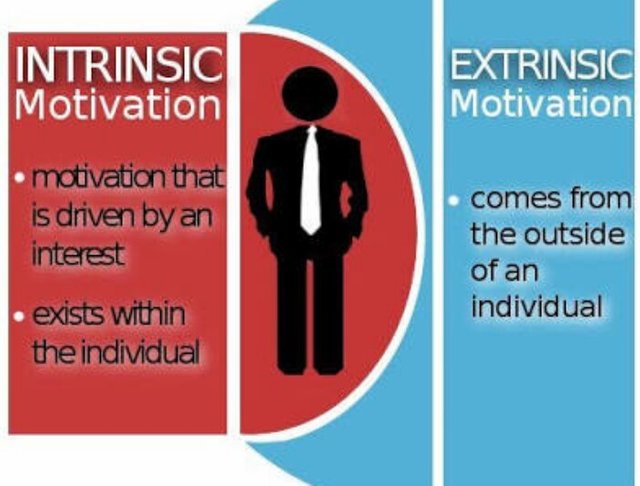Motivation: internal vs external, independent & in group, gender differences
Motivation can be defined as the incentive or stimulus for acting or behaving in a particular way. Motivation is normally the response to a need or desire of a person. McClelland (1985) states that motivation directs and energizes one’s behaviour. Motivation is comprised of two factors; namely intrinsic (internal) and extrinsic (external).
Many psychologists and others who study in this area have similar ideas on the definition of motivation. Here Bourne and Russo (1998) explain that it comes from a drive, which is a psychological state. This state arises from ones needs. Motivation is the force that exerts itself to fulfill such needs. Another definition of motivation by Murray, Poole and Jones (2006) is that motivation is simply a drive to fulfill a need.
Described by Grant (2008, as sited in Park and Word 2012, p. 707) motivation is likened to
an umbrella concept that captures the psychological forces that direct, energise, and maintain actionIt is the ongoing behaviour that fulfills ones need and impacts one’s behaviour.
It is said that motivation is driven by internal and external factors or the input of both. Intrinsic motivation is an internal factor and is self-satisfying. This means that a person’s desires will, themselves motivate that person to accomplish the desires.
Intrinsic motivation is characterised by meeting internalised performance standards which Sturman (1999) called an “achievement motivation”. Because intrinsic motivation is fuelled by internal desires, it does not seek external rewards such as praise or gifts (Cameron and Pierce, 2002). It is self motivated, one is able to push or direct them-selves to accomplish their goals. To be intrinsically motivated, one must experience enjoyment and have an interest in the task presented. One must also have a feeling of competency and self-determination.
Those who are intrinsically motivated will generally examine and judge their environment, take calculated risks and attempt to determine metrics that can be used to analyse their progress. As stated by Deci and Ryan intrinsic motivation is long-lasting.
On the other hand extrinsic motivation is the influence of external environment. Extrinsic is reward based reinforcement (Durga and Wallace, 2011). Socialisation and environmental influences are a large drive of extrinsic motivation such as family, teachers, wage, praise, etc. For example a young student who needs an offer of rewards to attempt or finish tasks by a teacher. However extrinsic motivation does have some instances where the characteristics are similar to intrinsic motivation.
Ryan and Deci talk about a four types of continuation that extrinsic motivation forms from and it is in the last two types where it has an internal presence.
Firstly the four types are
- external regulation,
- introjected regulation,
- identified regulation or identification lastly
- integrated regulation or integration (Ryan and Deci 2004, as cited in Park and Ward, 2012, p. 708).
These last two expressed in Park and Ward (2012) are similar to intrinsic motivation due to knowing and acting on their own choice of identification and integration from the influences that are seen in the environment. On a whole extrinsic motivation is referred to as a reinforced incentive. Deci and Ryan express that extrinsic motivation is short-lived.
Deci and Ryan proposed that intrinsic and extrinsic motivation differ in the use of outcome styles those being, autonomous and controlled. Deci and Ryan express that intrinsic motivation is the act of autonomy style, which involves acting and experiencing with a sense of choice, knowing and being in control of what one is doing.
Extrinsic motivation however is controlled style, which involves acting under pressure, an automatic response that isn’t thought through or controlled. Going on this theory of autonomous and controlled style, those who use more autonomous motivation (intrinsic) are assumed to be better off in psychological adjustment and well-being. Ryan and Deci go on to state that those using more controlled motivation (extrinsic) are associated with poorer psychological adjustment and ill-being.
Having discussed both the intrinsic and extrinsic components of motivation, it is noteworthy that these factors do not have a consistent effect on human behaviour (Durga and Wallace 2011). Everyone experiences motivation, at different levels, for different situations and use the motivation differently than others. Sengodan and Iksan (2012) express that motivation differs according to one’s needs and knowledge. Durga and Wallace (2011) agree with this adding, motivation is not constant and in different circumstances motivation differs, such as age, experience, education and aspirations.
Another example of different effects in motivation is gender. Tella (2007, as sited in Sengodan and Iksan. 2012) express a gender difference, in a study done on student’s academic learning. Male students seemed to have higher scores than female students. The study went on concluding that it showed that male students seemed to be more willing to work hard at subjects that they didn’t like.
One must bear in mind that this is one study and as expressed above motivation is not consistent and differs amongst everybody. Here are some other studies expressing their findings on the effectiveness of intrinsic and extrinsic motivation. These studies have different outcomes to the each other. This shows, as Durga and Wallace (2012) illustrated that motivation is not constant and it does vary.
In this first study presented by Schunk, Pintrich and Meece (2008, as cited in Sengodan and Iksan. 2012) they express that extrinsic motivation is a negative way to be motivated. Interestingly, despite the idea of negativity, extrinsic motivation has been shown to have a positive effect. For instance a teacher may motivate students by rewarding them in an attempt to encourage particular work outcomes, so due to this motivation the students do the homework but then they may only do homework on the expectation of receiving a reward.
In a study that was reviewed by Hayenga and Corpus (2010) it is put forward that intrinsic motivation is more effective than extrinsic. This stems from the idea that internally driven motivators are more durable than those based on external factors. This study attempted to correlate students’ middle school grades with the types of motivators they used. In this study they found that one who is motivated by self (intrinsic) has more likelihood of success than one who has motivation from external sources (extrinsic).
Those with high levels in both intrinsic and extrinsic motivation achieved quite well, whereas those with low levels of both types of motivators did not do so well. One can still do well if they have a high level of intrinsic alone however one does not do well with a low level of intrinsic and a high level of extrinsic; no matter how much more motivation was shown than those who used intrinsic motivation. Those who achieved well did so as they were motivated from within, having a desire to do well and succeed takes an individual a long way.
Even though extrinsic motivation is short-lived and may not be as effective as intrinsic motivation, Ross, Blecher, Yan and Hyland (2009) show that extrinsic motivation can be of great effectiveness. In the study it is explained that the rising prices of cigarettes affected people to think and act upon quitting. In places where the cigarette prices were higher so was the motivation of quitting higher of those who were smokers and living in the area. Whereas in places where the price was lower so was the motivation. There are times and different situations where extrinsic motivation is of great use.
One interesting influence on an individual’s level of motivation is the effect of group membership. An individual within a group where the level of the individual’s motivation can be seen to decrease where a group is present to take up the slack, this is referred to as social loafing. It has been observed that in cases of social loafing, “group members increase individual effort to make up for the lack of ability or effort of less-capable group members in a highly valued task” (Williams & Karau, 1991 as cited in Osborn, Irwin, Skogsber and Felz, 2012, p. 242).
This is not the only way motivation is affected with in groups. Group membership does not have a consistent impact on an individual’s level of motivation. Indeed participation in groups can actually serve to increase an individual’s motivational levels as well. “The Köhler effect occurs when less-capable group members increase their efforts on group tasks, particularly in highly interdependent tasks” (Osborn, Irwin, Skogsber and Felz, 2012, p. 242). It can hence be seen that group membership can serve to both increase and decrease the motivational level of an individual in a group.
In conclusion it has been shown that both intrinsic and extrinsic forms of motivation can have positive effects. Such effects were shown according to cited studies to be inconsistent as they vary with the demographic that the motivational influences are applied to.
As this was an academic paper I wrote there are a lot of references included in the text that I took out to make this piece shorter and easier to read, however if any one wants the complete references I can include them in the comment area.
Thank you, and I hope you found this interesting... stay motivated in all that you wish to do.




Very cool stuff, thank you for sharing. Though I must say, I think there are a lot more sociobiological factors that go into the comparison of standardized tests between males and females besides motivation
Thank you.
Yes there are lots of standardized tests between genders.. But my point is not about all the factors that produce differences between genders, but that gender is one of a number of factures that influence motivation.